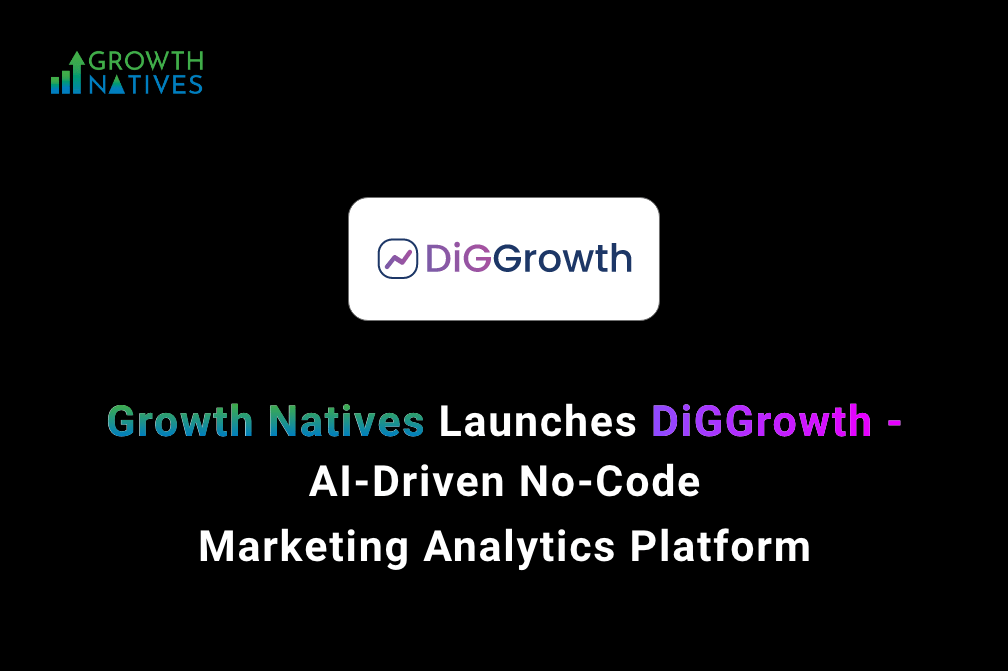
GA4 Migration Isn’t Automatic – Know How It’s Done
By Sakshi Arora
Oct 7, 202219 min read
Google is the most dominant player in the analytics market which commands over 55% of the market share. Since its launch in 2005, it has been a boon to marketers for helping them track traffic, understand markets, and improve visibility on search engines. Naturally, marketers around the world are rejoicing at the long-awaited launch of Google Analytics 4 which has been termed the “future of analytics”.
Alphabet Inc.'s recent announcement that it would cease processing data on Universal Analytics (the standard version of the tool) has met with cheers as well as apprehensions. Come July 1, 2023, Universal Analytics users won’t process any new data and existing data on the platform would become unusable if marketers don’t migrate it to the new platform. GA4 would become the sole analytics tool to track traffic and engagement in less than a year.
Universal Analytics was conceived in a browser-only environment with app-based smartphones still a few years away. It has served its purpose well for a long time, but the cross-platform world highlighted its limitations. Marketers had been complaining about their data being siloed with different teams in UA. This had become an obstacle to tracking a user’s complete journey when moving between websites and applications. GA4 solves this problem with a machine learning-based approach striking the right balance between cross-platform insights and privacy concerns.
Though a section of the marketers’ community had expected seamless and automatic migration from UA to GA4, it isn’t going to be the case. Naturally, there are doubts and apprehensions and the usual reluctance to come out of the comfort zone and try this revolutionary analytics platform. For starters, GA4 introduces several new features and customization options that would take data analysis to the next level.
In this guide, we shall look at different aspects of GA4 and educate you on the steps to migrate from UA/GA3 to GA4.
What Is GA4?
Google Analytics 4 or GA4 is the latest version of the analytics tool. It has undergone a complete overhaul with the focus shifting from tracking traffic to engagement. Unlike its predecessor, it isn’t a web-only tracking tool but introduces app tracking as well to align itself with the realities of a cross-platform world. Formerly known as App + Web it was launched in the beta format in October 2020 showing its capabilities.
GA4 has been long awaited in the marketing industry as marketers had to rely on UA and other app tracking tools. Shifts in consumer behavior and the latest data privacy laws have been the genesis of GA4. An internal study by Google had concluded that Universal Analytics had served its purpose and it was not providing marketers with complete insights in a cross-platform world. GA4 will let marketers analyze customer usage metrics in a cross-platform environment with the focus shifting to events from traffic along.
With this new analytics tool, you can track customers’ complete journey and interaction with your web and app platforms on a single dashboard. The deeper insights are likely to influence the development of campaigns and ensure optimization of digital presence delivering better results. A new reporting feature has also been added where you can customize the reporting based on your exact needs.
GA4 leverages AI (Artificial Intelligence) and ML (Machine Learning) and lets you gain detailed insights into how customers interact with your website and apps. It is no longer about where the users come from and where they go but what they actually do during those engagements. The latest privacy laws such as the European Union’s GDPR (General Data Protection Regulation) and CCPA (California Consumer Privacy Act) have also been key triggers for this analytics tool.
What Is the Difference Between UA and GA4
Universal Analytics has served users well over the years. But the cross-platform environment and privacy concerns have exposed its limitations. Google has addressed these challenges by going back to the drawing board. GA4 is a complete overhaul rather than the standard update of a tool. Here are the key differences between these two tools:
Event-Based Tracking in GA4 Vs. Session-Based Tracking in UA
The main difference between Universal Analytics and GA4 is the data models they use. UA is based on pageviews and sessions, while GA4 focuses on parameters and events. This data model allows brands to track a customer's journey. It offers a unified view of the journey across web and app platforms instead of looking at the journey through the prism of numbers and stats as we have gotten used to with Universal Analytics.
Focus on Goals
In the latest version of analytics, the focus has shifted to goals. For example, in UA, conversions would be measured in a pre-defined manner, such as selling a product for an ecommerce store. The absence of a transaction would be viewed as a failure of the campaign. However, GA4 focuses on goals. Events that contribute to the final objective of the brand shall be treated as a goal conversion. Another significant difference is with reports. It has simplified tracking as it has done away with standard reports and offers more scope of customization.
Monthly Hit Limits
Universal Analytics had a 10 million hit limit, a significant limitation for the users. Thankfully, Google had done away with this limit in GA4. However, the latest version comes with a limit on the number of events that can be tracked. But the current limit of 500 events is a lot for any business using Google Analytics.
BigQuery Free Connection
It was previously available only to paid users on GA360. Users would get a free connection to BigQuery on GA4. This is a welcome move as BigQuery lets analysts query extensive and complex datasets.
Custom Reporting
Universal Analytics had many standard reports, but users would find fewer options in GA4. This would allow users to create custom reports to track data they want and avoid dealing with meaningless data. The UI is similar to Google Studio, where custom reports can easily be generated for different users and roles.
What Is New in GA4?
Universal Analytics has served businesses and marketers well for years, but it had a major limitation. As we have already mentioned it was a web-only tracking platform with a focus on traffic and its sources. GA4 has been aligned with the present needs of the marketers and it allows in-depth analysis of events both on websites as well as applications.
GA4 has introduced several new features:
Insightful Dashboard – The first thing one notices on GA4 is the new dashboard. It is more insightful in comparison to the Universal Analytics dashboard that you may have gotten used to. GA4 makes it easy to build and maintain audiences from web and app on this new and cleaner dashboard.
Event-Based Tracking – The feature that is most talked about in GA4 is event-based tracking. This is a big shift from UA where the focus was on page views, sessions, and users. This feature has got marketers worked up as it would take some time to get used to as all of us unlearn analysis based on traffic alone. On the positive side, it would let us gain more granular data to optimize campaigns.
Privacy Controls – Privacy has been a much-debated topic with the latest legislation being passed. GA4 has been built ground-up with privacy as one of the key problems. It introduces advanced features that let you control the data you collect from the users and how they are used in your campaign and remain compliant with the GDPR legislation.
Customization - With GA4 you will have more customization options for your dashboard and see reports that matter. If you are already using Google Data Studio you will be able to create custom visualizations based on the events data on your web and app properties.
Tracking Events – GA4 makes data tracking and analytics free from developers! You won’t have to rely on a development team while tracking events. Apart from basic events such as engaged sessions, engagement rate, and engagement time you can create custom events and run up to 300 events on every property.
Why Should You Move to GA4 Now?
We have already covered the basic improvements in GA4 over UA and looked at their differences. If you are using Universal Analytics, you will eventually have to make the move to the new platform. However, we recommend making the switch now. Is there an urgency? Yes, and here are some reasons why you need to make this move ASAP.
The Clock Is Ticking
GA4 is the future of Google Analytics and there is no escaping from it. Even if you are a doubter you will have to make the switch as the July 2023 deadline is fast approaching. Alphabet Inc. has already announced its intention of pulling the plug on UA on 1st July 2023 and historical data would be available on the platform for another six months before they pull down the curtains completely on UA.
There would be no automatic upgrade to the new ecosystem as they are built on completely different technologies. The only option for retaining some of your old data is through migration. Not all data can be migrated to the new system, and you will have to leave behind some trash on UA.
Expanding the Data Range
GA4 is introducing a completely new philosophy to analytics as we have discussed in the previous point. It works as a forward-facing system wherein it will process data from the time GA4 is implemented. Thus, marketers won’t be able to import all their past data from UA in this new environment.
Switching early would let you have access to more data, and this may prove handy in the future. You can also take advantage of the new features available on Google Analytics 4 for your current campaigns.
Moving Existing Data
Though GA4 won’t let you migrate your data lock, stock, and barrel to the new property, some of your existing data can be migrated to the new ecosystem. However, there are some ways in which you can expert existing data to your new GA4 property.
This won’t be possible after Google pulls the plug on UA. You can explore different options of moving existing data as this will let you retain maximum data for future use. Hence, if you wish to retain your data, you should make the move without any delay.
Familiarization
As we have already mentioned GA4 comes with a completely new interface. From measuring metrics to reporting, GA has undergone massive changes. The Reports section alone would take you some time to get started with. There are lots of customization options that include analyzing conversion funnels, user journey, cohort analysis, etc.
It is as good as training yourself on a new analytics tool. The earlier you switch the more time you will have to familiarize yourself with the new property. The ability to view a UA property simultaneously is also an advantage. This will help you gain better insights into the advancements in GA4.
Why Migrate From UA to GA4 Now?
As we have discussed in the previous section, moving to GA4 is fait accompli. You can’t stick to UA for too long. Let us keep aside the deadline for a while and ask the most important question of all – should you switch to GA4? The answer is a bold YES. Google Analytics 4 holds a lot of incentives for marketers. It promises to offer deeper insights on customer engagement, especially in the post-cookie world.
If you can’t wait to leverage actionable insights and use them to power your marketing campaign, Google Analytics 4 is well-suited. If you are still looking for convincing reasons here are some reasons why you should migrate from UA to GA4.
Mapping Customer Journey
Universal Analytics was conceived in an era where marketers were focused on pageviews and traffic. The world has moved on and advanced analytics involves mapping a customer’s journey. GA4 introduces the event-based data model where the focus is on tracking user interaction events that offer a wider understanding of the customer’s journey.
In the past tracking customer’s journeys across platforms posed a challenge with every technology having dynamic metrics and tracking models. GA4 offers a solution to this problem with the new Google Signals feature that allows seamless event tracking across platforms.
Integration with Google Ads
GA4 enables deeper integration with Google Ads. This is a shot in the arm for marketers. This will let you build and maintain audiences from web and app platforms. For instance, if a user who is on the audience list for your web marketing campaign completes a purchase on the app or vice versa, the list is updated automatically. The user won’t be retargeted with ads.
Web & App Tracking
If you are looking for one USP for making this move, this is the one. As we have mentioned earlier GA4 lets you track events both on websites and mobile applications. You can consolidate data from websites and mobile applications to get better insights on engagement. Different data streams can be integrated easily in GA4. This does away with the need to use two different analytics tools for web and app and consolidate their data manually.
Custom Reports
GA4 has introduced a custom reporting feature. This does away with irrelevant and pre-made reports in UA. Thus, your dashboard is less cluttered, and you will be able to spot and track the data that is relevant to your business. This keeps your mind focused and helps you analyze the most important data for your business. GA4 also provides a search bar that lets you search for data instead of having to rely on reports as was the case with UA.
Data-Driven Attribution
In UA marketers were compelled to assign all credits to the last ad clicked before a purchase. This limited the scope of understanding the real point at which the customer was convinced about buying the product. GA4 introduces a data-driven attribution model offering insights into the customer’s entire buying journey. This can help in optimizing campaigns based on their success and improving the ROI.
Predictive Insights
GA4 relies heavily on AI and Machine Learning. The predictive insights feature would change the course of marketing campaigns in the future. With predictive metrics, you can learn more about your customers’ future actions using structured event data. For instance, this feature can tell you whether a customer is likely to renew a subscription to your tools based on their present activity with your tools.
Upcoming Features
Finally, GA4 is a work in progress, and we have already seen new features and upgrades being rolled out since its Beta launch. We expect to see new features and functionalities being added as more people make the switch in the coming months.
How to Migrate from UA to GA4?
We have discussed the benefits of migrating to GA4. We have also talked about the urgency of the migration. This brings us to the most important segment of all – the migration process itself. You must remember that GA4 is a completely new ecosystem and hence it doesn’t quite work in the traditional sense of migration. Here is a step-by-step guide to migrating from UA to GA4.
Step 1:
In your Google Analytics Console, navigate to Admin on the bottom left corner and click on Create Property.
Add Property Name, set up Reporting Time Zone, Currency, and click on Next; and then, Create.

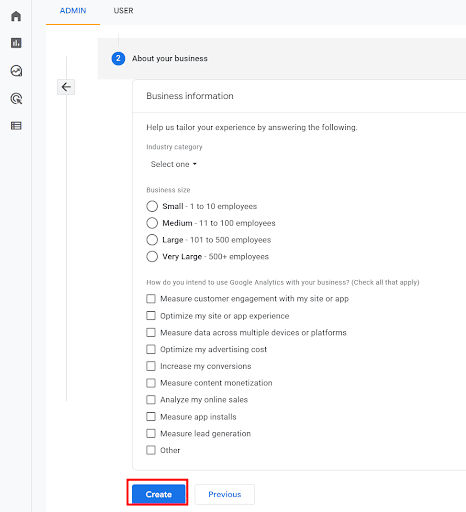
Step 2:
After creating a new GA4 property, navigate to Admin. Click on Data Stream and choose a platform based on your requirement.

Step 3:
Add the website URL and a Stream Name with which you can identify the platform and website/app.

By this time, you will have a GA4 property successfully created. The next step is to implement the same on your website/ app so that you can track visitors and their actions using the Google Tag Manager (GTM).
Setting Up GA4 Tracking using GTM
Simple! Take the following steps to enable tracking with GA4:
Step 1:
First things first, you need to make sure that your website contains the Google Tag Manager snippet of your respective container at the required placements.
Step 2:
Now navigate to Workspace and choose Default Workspace where you will be publishing the changes on the container. Then, click on the option of “New Tag” & “Add a new tag”.
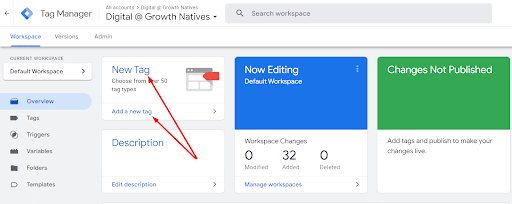
Step 3:
As a next step, click on "Tag Configuration" where you can see multiple types of tags to choose from.
Select “Google Analytics: GA4 Configuration.”
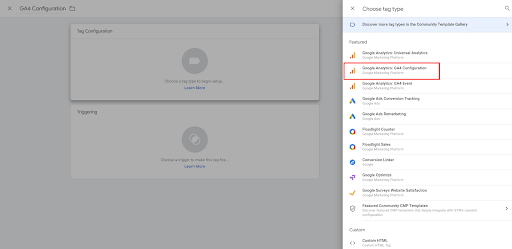
Step 4:
After clicking the Google Analytics: GA4 Configuration, copy your Stream Measurement ID and paste it under "Measurement ID" in the Tag Type section.

Once you enter the Measurement ID, you need to set up a Trigger where the GA4 Tag will get activated.
Step 5:
Click on “Triggering” to choose where you want to fire the Tag on your website/app.
In the majority of the cases, you would likely want to fire GA4 on All Pages. However, the setup may vary based on the requirements as in some cases, you may avoid tracking App Domain or Login Sections.
Step 6:
Save your Tag and publish your Google Tag Manager Container to push it to Live.
Once you publish the GTM Container Live, you will see the GA4 firing on your website/ app. To test if GA4 is working and tracking correctly, check the Real-time overview section in the dashboard.
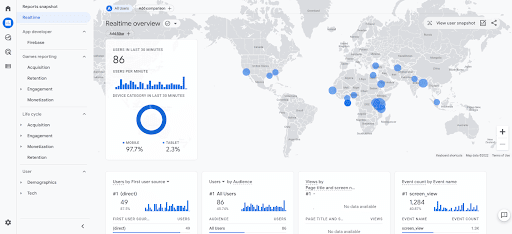
Events in GA4
We know by now that Google Analytics 4 offers event-based data collection to replace traditional session-based models. While some events are automatically created, others may need an enhanced measurement for them to appear in the analysis. In addition to these, you can also create custom events with a specific combination of parameters you want to measure.
How to Set Up Custom Events in GA4 Using GTM
One of the newest and most notable improvements that have come up with GA4 is the built-in event tracking under Enhanced Measurement to fire events such as Scroll, Outbound Link Clicks, and Video Views File Downloads which you previously needed to create manually.

Well, there always arises a need to track certain activities which are unique in nature depending on the structure of your website/ app. So, in order to track those, you need to set up Custom Event Tracking using GTM.
Again, in a few steps, you will be ready to track such events.
Step 1
To get started, create a new tag with the Tag Type "Google Analytics: GA4 Event". Choose the GA4 Configuration Tag that you recently created under Configuration Tag.
Step 2
Enter the event name that you would like to see within Google Analytics.
Click on Event Parameters to add the parameters’ names and values. Event Parameters are used to send additional details about the event to Google Analytics.
Step 3:
You will need to create a Trigger to determine the values that you want to track.
Click on the Trigger section to either create a new trigger or choose an existing one.
Step 4:
Finally, after setting up the GA4 Event Tag and Trigger, you need to Save the Tag and publish it Live. Therefore, you will see the Events along with additional parameters populating the data in the Event section in your GA4 Property.
The question is, which events you must track on your website?
What Events to Track in B2B Websites
There are ‘n’ number of events for which you can set the tracking in GA4. The events will vary from website to website and app to app, depending on the structure of how it is built and what type of business they are dealing with.
Before setting up Custom Events for your B2B website or mobile app, you need to study the full website or app. There are multiple Custom Events that are common across the majority of websites and apps and are listed below:
Navigation Menu Tracking
- Menu_Item
- Menu_Text
- Sub_Menu_Item
- Sub_Menu_Text
Form Submission Tracking
- Newsletter_Subscription
- Contact_Form_Submit
- Assets_Form_Submit
Page View Tracking
- Page_View
- View_Press_Release
- View_News
- View_Asset
- Video_View
Conclusion
The marketing world has changed since the time Universal Analytics was launched. We live in an era where marketing has moved to a cross-platform environment. Google Analytics 4 is aligned to the constantly shifting dynamics in the present digital ecosystem. It is more powerful than UA and provides marketers with more relevant and granular insights on their customers and their journey on the web and app.
We have witnessed a shift in the core aim of data analytics. It matters more to know why users are on a website or app rather than where they come from. Google Analytics 4 property lets you gain a complete cross-channel view of user interaction on web and app platforms. It introduces predictive marketing features that offer deeper insights on work on those insights meeting customer aspirations.
Google Analytics 4 will be the default option for now and the only Google Analytics property in the future. An early switch can help you get accustomed to the ecosystem and create a wide data range. The countdown to Universal Analytics’ much-deserved farewell has already started and it's time you make the switch.
Growth Natives is a trusted technology partner for businesses across the world and our experts can help you seamlessly transition into GA4. To discuss further, shoot us an email at info@growthnatives.com and let's take it from there.

